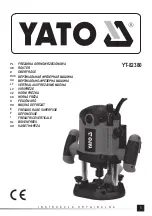
15
O R I G I N A L I N S T R U C T I O N S
GB
The purpose of the tool
The tool is used for processing wood by means of shank cutters guided from the top of the workpiece along its surface. It is also
possible to process wood-based materials such as MDF, chipboard, plywood, etc.
The processing of materials other than wood and wood-based materials, such as plastics or metals, is prohibited. Do not use
the tool as a stationary tool or as a drive for other tools. The user is liable for all damage resulting from improper use of the tool.
Residual risks
Even if the tool is used correctly, there are residual risks which cannot be avoided. The following hazards arise from the construc-
tion and use of the tool: contact with the rotating cutting tool; ejection of the inserted tool or its parts; ejection of dust and pieces
of wood; inhalation of dust generated during work; hearing damage if no hearing protection is used; electric shock when touching
non-insulated parts of the tool. Failure to follow the instructions in the manual may be the cause of other hazards resulting from
improper use.
Additional safety instructions
Always hold the tool by the insulated handles when working. The inserted tool may come into contact with the tool’s power cord or
with another hidden “live” cord. Such contact may cause uninsulated parts of the tool to become live and may electrocute the operator.
Always attach the workpieces to a stable base, e.g. a work table. Never hold the workpiece with your hands, legs or other body
parts. The correct clamping of the workpiece will reduce the risk of losing control of the tool and body contact with moving parts
of the tool. When processing long workpieces, support them near the machining point and near their ends. Long elements tend to
bend under their own weight. The supports must be positioned so that the bending parts of the components do not catch the tool.
Use only cutters with the diameter of the handles specifi ed in the manual. Do not rework the cutter handle to fi t the tool socket.
Use the sleeve and nut to match the diameter of the handle. Before installing the cutter, make sure that its speed is greater than
or equal to the speed of the tool.
Processing some materials can generate dust which can be harmful if inhaled. Always use dust masks during operation. You
should also connect the tool to the dust extraction system whenever possible.
Check the tool and the inserted tool for damage before each use. If you notice any damage, do not begin work until the damage
has been repaired. Pay special attention to the power cord. The damaged power cord cannot be repaired and must be replaced
entirely. Replacement must be carried out at an authorised service centre. Always pull the power cord by the plug when unplugging
it from the socket, never by the cord.
Wear personal protection equipment during work: eye protection, hearing protection, dust mask, protective clothing with long
sleeves and legs, protective gloves, helmet and footwear with anti-slip soles. Long hair should be tied up.
All activities related to the assembly and adjustment must be carried out with the tool power supply disconnected. The tool power
cord must be unplugged from the socket. Make sure the on/off switch is in the “off ” position before connecting the tool to the
power supply.
Before using the cutter, make sure that the cutting edges are free from damage and properly sharpened. Damaged cutting edges
can cause the cutter to jump away from the workpiece, cause uneven work results and the cutter to crack. Imperfect edges will
require the cutter to be pressed with greater force against the workpiece, which can cause the workpiece to burn and also cause
the cutter to crack.
Do not use cutters with a larger diameter than the dimensions of the opening in the base. After mounting the cutter in the plunge
router spindle it should not block the lowering and lifting of the plunge router housing.
TOOL OPERATION
Preparing for operation
Take the tool and accessories out of the packaging and remove all its parts.
Due to the reduced size of the packaging, the plunge router is delivered set in the lowest position. Place the plunge router on its
sole plate and then hold the top of the housing with one hand and using the other hand, turn the stroke lock lever counter-clock-
wise (II). The springs in the brackets will raise the plunge router housing. Use your hand on the top of the housing to generate
slight resistance so that lifting is not too abrupt.
Fully unwind the power cord.
Connecting the dust extraction system adapter
The dust extraction system adapter consists of two components: a transparent connection for the dust extraction system and a
metal mounting plate. The dust extraction system can only be used for cutters with a diameter smaller than that of the opening
in the mounting plate.
The adapter shall be mounted to the opening in the upper part of the sole plate so that the dust extraction system connection is
directed away from or towards the operator (III). Fasten the adapter with screws. Do not tighten the screws too much to avoid
damaging the adapter.
An industrial vacuum cleaner can be used as a dust extraction system. It is not recommended to use a household vacuum clean-
er, which is not suitable for absorbing dust generated during wood processing and may be damaged during such work. Always
connect a fl exible hose to the tool connection, which allows the tool to operate freely. Position the hose so that it does not come
















































